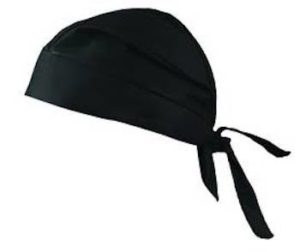
*The western history and heritage of the Do-Rag are featured on this date in 1800.
A Do-Rag is a cloth covering the head, also spelled doo-rag, du-rag, and durag. According to the Oxford English Dictionary and Merriam-Webster, the term derives from do, as in hairdo: a do-rag is often worn to protect a processed hairstyle. The do-rag has been prevalent throughout many eras and is not a recent Black fashion in America. For centuries, men and women of African descent from around the world have used various fabrics and scarves to cover their hair.
The custom is also known from ancient China, where wrapping the hair (often held in a topknot) was common during physical labor and military service. Large silk handkerchiefs (or bandanas) are frequently found in Latin America, typically worn under a Panama hat. They have commonly been seen in the Dominican Republic, Puerto Rico, Cuba, Colombia, & Peru (this custom came from the African slaves brought to this part of the Spanish-speaking world during the Middle Passage). These handkerchiefs were widely used at one time, worn by the Spanish of the American Southwest. It was common to see a black or white silk bandana worn under a matching black or white bolero hat by the Spanish horsemen or vaqueros. The most notable example is the one worn by the fictional character Zorro.
In the 1930s, American women began wearing bandanna-like clothes to fasten their hairstyles while their hair was set. In the 1940s, the style among women shifted into the workplace, where they were taking over factory jobs and needed a safe way to keep their hair out of the machinery. Rosie the Riveter is famously featured wearing the blue-collar woman's do-rag. From the 1930s to the 1960s, they were used by Black men to hold chemically processed hairdos in place while they slept. Initially, they were made from pieces of handkerchief, bandannas, or women's stockings; now, many are made from polyester. Do-rags resurged as a fashion trend among urban youth in the 1970s and 2000s. Do-rags are worn in various colors, with black being the most common.
Do-rags are regularly used to create and maintain waves. They are also used for corn-rowed hairstyles. They usually have long ties on either side wrapped around the head to secure the do-rag and tied at the back. It is also used by women who have had Japanese Hair Straightening done to their hair and is worn by motorcycle riders to keep their hair from blowing into their face and eyes, bugs out of their hair, and to absorb sweat. Many African American men use do-rags to maintain the wave patterns in their hair. After brushing, oil sheen or grease is used on the hair, wrapped in a do-rag overnight to keep the wave pattern. Some gang members wear do-rags to represent their gang colors. In 2001, the National Football League banned its players from wearing do-rags and bandanas underneath their helmets. The ban did not apply to players who wore them for medical reasons.
A do-rag is also similar to the 'mitpachat': an Israeli style of head covering worn by Orthodox Jewish women. It comes in various colors and fabrics but is often longer than the average do-rag and tails down the back of the neck. Women wearing the mitpachot often cut their hair short as part of Jewish law stipulating that a woman's hair must be covered once married. Some women prefer to keep their hair long and tie the mitpachat in a knot at the back of their head, covering the hair. Mitpachot are color-coded to match clothing, but white is popular on special occasions.